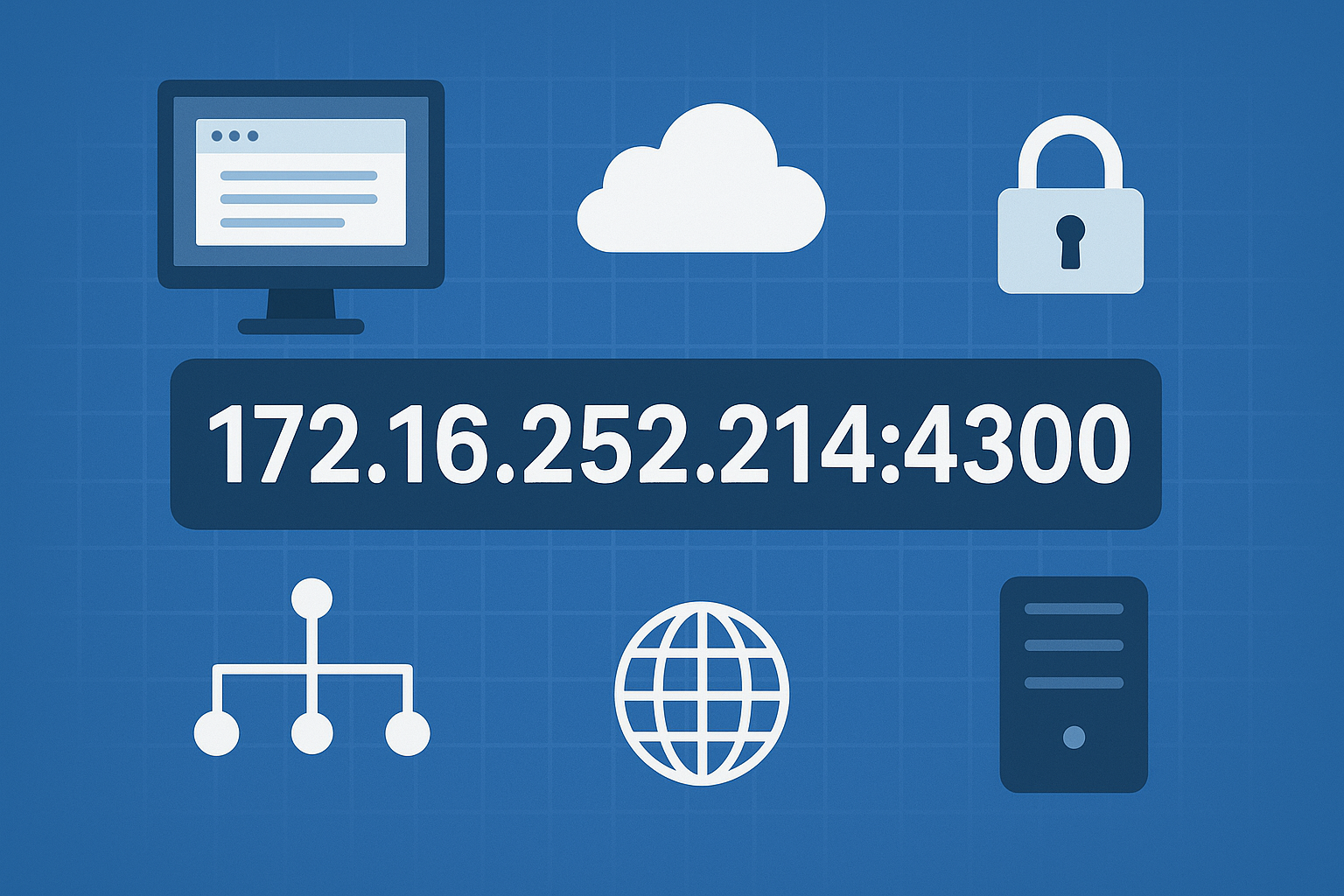
Understanding 172.16.252.214.4300: A Deep Dive into Private IPs, Ports, and Network Management
In the world of networking, numbers tell stories. One such example is 172.16.252.214.4300, a combination that might look confusing at first glance but actually represents something fundamental to how modern computer networks operate. To a networking professional or system administrator, this type of notation reflects a private IP address and a port number, two crucial elements that enable secure and efficient communication between devices within a network. Understanding what 172.16.252.214.4300 represents opens the door to a deeper comprehension of how data moves across systems, how applications are accessed internally, and how organizations manage digital infrastructure safely.
What Does 172.16.252.214.4300 Represent?
The address 172.16.252.214.4300 is composed of two parts: the IP address (172.16.252.214) and the port number (4300). The first portion, 172.16.252.214, falls within the 172.16.0.0 to 172.31.255.255 range, which is officially designated for private networks by the Internet Assigned Numbers Authority (IANA). This means it cannot be accessed directly from the public internet and is typically used within corporate LANs (Local Area Networks), data centers, or cloud-based private environments.
The second component, 4300, is a port number — a virtual endpoint that allows specific applications or services to communicate. When we see 172.16.252.214.4300, it usually points to a service running on a device with the IP 172.16.252.214, listening on port 4300. That service could be a web server, a database, an application interface, or any custom-built internal tool. Together, this combination acts as a precise locator for network traffic, ensuring that data packets reach the correct service running on the correct machine.
The Role of Private IP Addresses Like 172.16.252.214
Private IPs such as 172.16.252.214 are essential to how organizations design and secure their internal communication systems. Unlike public IP addresses that are globally unique, private addresses are reusable across different networks. For instance, multiple companies might use 172.16.252.214 within their internal systems without causing conflicts, because those networks remain isolated behind routers or firewalls that use Network Address Translation (NAT) to handle external connections.
By using private IPs, businesses can avoid exhausting the limited pool of public IPv4 addresses while maintaining strong internal segmentation. The IP 172.16.252.214 might be part of a server subnet, a virtual private cloud, or even an internal testing environment where developers run applications accessible only via the internal network. When combined with a port number like 4300, administrators can create multiple access points on the same IP for different purposes, increasing flexibility while keeping systems organized.
The Importance of Ports: Why 4300 Matters
While IP addresses identify devices, port numbers identify the specific services running on them. Common ports such as 80 (HTTP), 443 (HTTPS), and 22 (SSH) are widely recognized and often exposed to public networks. However, port 4300, as seen in 172.16.252.214.4300, is not standardized for any specific service by default. This means that organizations can assign it to any application they wish — for example, a custom API, a specialized monitoring service, or a proprietary business application.
Using non-standard ports like 4300 can also serve as a basic layer of obscurity — while not a true security measure on its own, it helps reduce the surface area of automated scans looking for vulnerable services on common ports. In internal systems, port 4300 might be tied to an internal web dashboard, a secure backend process, or a communication gateway between services. Regardless of the exact function, administrators must ensure that port 4300 is properly configured with the right access controls, firewalls, and monitoring rules.
Accessing and Managing Services on 172.16.252.214.4300
Accessing something like 172.16.252.214.4300 requires being connected to the internal network where that address resides. Since the 172.16.x.x range is private, external users cannot reach it directly over the internet. Employees or contractors might use a VPN (Virtual Private Network) or a bastion host to securely enter the network and then connect to services hosted on 172.16.252.214.4300.
Once inside, the service might be accessed through a browser or client by specifying the full address — for example, entering http://172.16.252.214:4300 into a web browser if it’s a web-based interface. Network administrators often use tools like ping, netstat, or nmap to test connectivity, verify open ports, and ensure that services like the one hosted on 172.16.252.214.4300 are operational and properly secured.
Security Considerations for 172.16.252.214.4300
Security should always be a top priority when managing private services such as those running on 172.16.252.214.4300. Even though private IPs are not directly reachable from the internet, insider threats, misconfigurations, and malware can still exploit vulnerabilities within the local environment. System administrators should apply defense-in-depth strategies that include network segmentation, access control lists (ACLs), and continuous monitoring.
Firewalls should explicitly allow only authorized users and systems to reach 172.16.252.214.4300. Encryption should be used for any data transmitted between clients and the server, even within private networks, since internal threats and packet sniffing are not uncommon. Regular patching and software updates are also critical — if the service on port 4300 uses an outdated library or framework, it could become a weak point for attackers to exploit.
Additionally, logging and monitoring tools such as SIEM (Security Information and Event Management) systems can track all connection attempts to 172.16.252.214.4300, alerting administrators to unusual behavior like repeated failed login attempts or connections from unexpected subnets.
Troubleshooting and Maintenance
Maintaining reliable access to 172.16.252.214.4300 requires ongoing monitoring and testing. Network engineers frequently employ diagnostic utilities to ensure the server hosting that address is performing well. Common checks include verifying that the service on port 4300 is running, that latency remains low, and that no firewall rules accidentally block legitimate traffic.
In cases of connectivity problems, the first step is to verify that the IP address 172.16.252.214 is still assigned to the correct host. Changes in DHCP configurations, virtualization environments, or container deployments can sometimes reassign IPs automatically. Next, administrators check whether the application bound to port 4300 is active. If not, restarting the service or reviewing its log files often reveals the root cause.
Proper documentation of network assets — including details about which system owns 172.16.252.214.4300 and what it hosts — is invaluable during such troubleshooting processes. Without that, identifying the problem can take much longer, especially in large enterprise networks.
Best Practices for Using Private IPs and Ports
Organizations that depend on internal services like 172.16.252.214.4300 should follow best practices to ensure both stability and security. Using consistent naming conventions, centralized configuration management, and automated deployment pipelines can prevent errors and misconfigurations. Implementing role-based access control (RBAC) ensures that only authorized personnel can modify settings or view sensitive data.
Regular audits of all services running on non-standard ports, including 4300, help identify potential misuses or outdated software. Network administrators should also maintain clear network maps and up-to-date documentation showing which private IPs correspond to which applications. These proactive measures make it easier to scale, troubleshoot, and secure networks effectively.
Conclusion: Why 172.16.252.214.4300 Matters
At first glance, 172.16.252.214.4300 might appear to be just another technical identifier, but it represents the intersection of many vital networking principles — addressing, segmentation, service management, and security. Whether used for internal development, private web services, or enterprise systems, such configurations are the backbone of digital infrastructure. Understanding the role of private IPs like 172.16.252.214 and ports like 4300 helps professionals design safer, more efficient networks that power modern organizations.


